Both BMP and TIFF are very well established image file formats, particularly when it comes to saving your files in Photoshop.
Although they have some similarities, there are far more differences between BMP vs TIFF than you might expect, which we are going to fully investigate in this article.
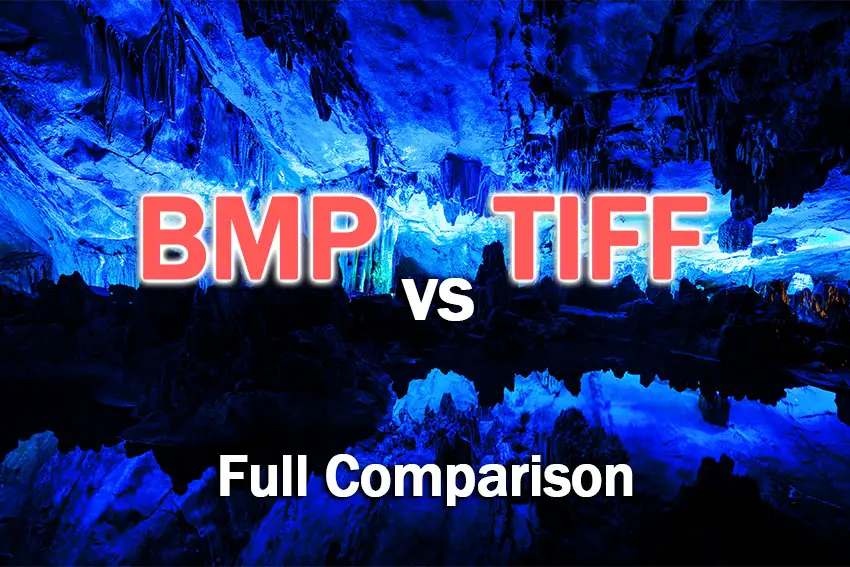
BMP vs TIFF Quick Comparison
BMP files are ideal for retaining image quality in long term storage as they are uncompressed and support transparency, while TIFF is best for saving in-progress photo edits as TIFF files support layers and 32-bit color channels.
You can find all of the key differences between TIFF and BMP in the table below.
| BMP vs TIFF Comparison | BMP | TIFF |
|---|---|---|
| Image Quality | Perfect image quality. | Perfect image quality. |
| Color Depth | 8 bits per channel maximum. | 32 bits per channel maximum. |
| Support for Transparency | Yes. | Yes. |
| Support for Layers | No. | Yes. |
| File Size | Large sizes. | Larger file size, especially with layers included. |
| Support | Widely supported, even though being obsolete. | Supported by most applications, but sometimes with some limits. |
What’s the Difference Between TIFF and BMP?
The BMP file type was created around 30 years ago by Microsoft to allow images to be displayed on a Windows device, while TIFF was originally owned by the Aldus Corporation and was a proprietary format, although is now owned by Adobe.
Both file formats will provide you with perfect image quality, but TIFF has higher color depth support, although its 32 bits is unlikely to be used by most people in practice.
BMP saves each pixel separately, without any compression, and it is limited to 8 bits per channel.
Both file types support transparency, and both are widely supported in editing software solutions and operating systems.
TIFF has the upper hand in supporting layers, so for complex photo edits, it will keep all layers if you choose to do so, or for multi-page scans, it can work pretty much like a PSD file by keeping all the pages in a single file. BMP can’t do that.
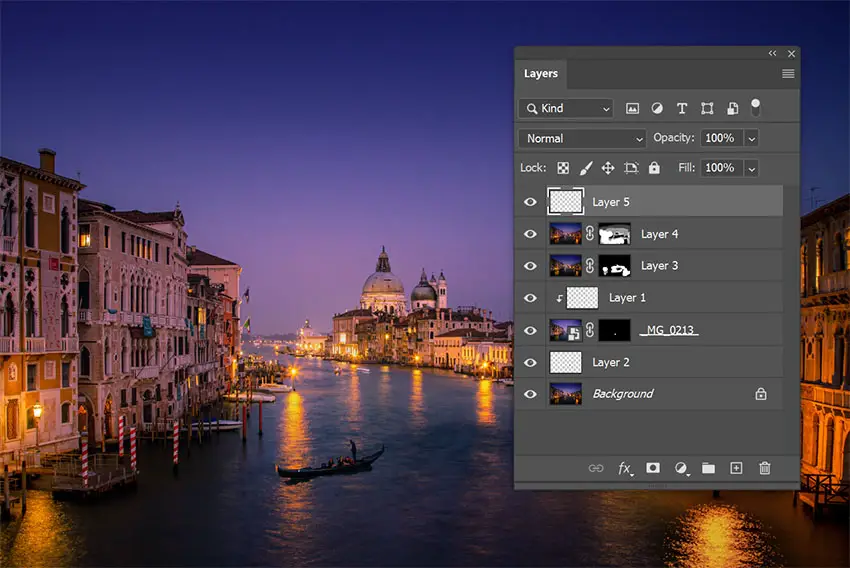
If you need to save a graphic with transparency for web use, BMP produces smaller, simpler, and clean files that are supported by every browser, despite technically being an obsolete format. TIFF can’t really do that while being lightweight and supported.
For print, TIFF is a better option since it can support higher color depth and handles different color modes better. BMP is designed for RGB, while with TIFF, you can use CMYK with ease.
If you intend to save your image for viewing purposes, both files will handle the quality essentially the same. That is because most of the screens around you are barely 8-bit per channel.
If it is not a high-quality IPS panel or a good OLED, you aren’t even getting a real 8-bit per channel image. Instead, you get 6-bit color depth, with the last 2 bits being “massaged” to fit in the 6-bit.
High-quality displays can go up to 10 bit, but no display can reach 32 bit per channel color depth.
What are the Pros of TIFF?
The main advantages of TIFF over other file formats are the color depth, various lossless compression methods, and layer support.
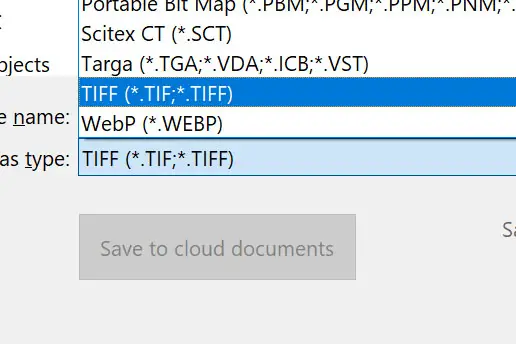
In other words, you can save a TIFF file as much as you want, and you won’t lose any quality or details. Moreover, you can even save all the layers you have created in Photoshop, so you can go back and edit anything whenever you want. The compression algorithm will reduce the file size significantly but never at a loss of quality.
Given that the file type is widely accepted by all editing software solutions, not just Photoshop, if you ever change your workflow and the software you use, your edits with all the layers will still be available and editable.
Almost all photo printers can accept TIFF files without any conversions. Thus TIFF (even with layers) is the most used file format for print.
In brief, the advantages of TIFF files are:
- Highest image quality.
- Supports layers for non-destructive editing.
- Lossless compression.
- Can handle different color spaces like CMYK.
What are the Cons of TIFF?
The only real negative of TIFF files is that they produce very large image files. You can easily end up with a file size ranging from 50 MB to several GB’s, once you add a number of layers within Photoshop.
TIFF’s are also less compatible with web galleries like 500px or Flickr, and many of the smaller online photo labs do not accept them to print your photos, as they are too large.
So, the disadvantages of TIFF files are:
- Layers increase file size significantly.
- The maximum file size is 4GB.
What are the Pros of BMP?
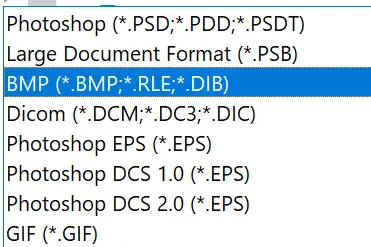
The way that the BMP file was designed allows you to retain image quality by saving each pixel data without any compression.
That means you won’t lose image quality if you save it into a BMP file format. Moreover, the BMP file format supports transparency.
Being a file format created by Microsoft over 30 years ago, it means that you can open it on pretty much anything. It is a simple file format to decode. Thus it is widely supported.
Briefly, BMP pros are:
- Perfect image quality.
- Widespread support.
- Transparency.
What are the Cons of BMP?
Since it is a file format designed to be simple and with limited usage, it means that it has been superseded by other file types that can do everything that BMP can do but better.
So, having no compression means that BMP files can get extremely large unless you limit the image’s dimensions. The more pixels you have, and the higher the bits per channel, the bigger the file will be. No matter the content.
That means even if you have several pixels with the same values, they will be treated as copies and occupy a lot of space.
File formats with lossless compression use techniques like saving the identical pixels once (as a single-pixel) with all the data and then just mark where it needs to be copied when the image is seen. That way, the file is smaller, and no quality is lost.
Moreover, it is limited to 8 bits per channel, so saving a photo from modern cameras that can produce 14 bits per channel RAW files means that you will be sacrificing color depth.
In brief, BMP cons are:
- No compression and each pixel is stored separately, meaning file sizes will be huge.
- Limited to 8 bits per channel.
- Obsolete, replaced by better and more efficient file types.
BMP vs TIFF for Printing and Scanning

There are several ways you can print a photo, however in essence, printers are split into two groups: RGB and CMYK printers.
RGB printers are usually dedicated photo printers, while CMYK printers range from simple home printers to massive industrial-scale machines.
The reality is that BMP is limited to RGB color space, while TIFF can handle various color spaces, including RGB and CMYK. That, in turn, makes it a better choice for printing since it can satisfy almost all printing needs.
Scanning, on the other hand, is a different story.
Each file type has different pros and cons depending on the scan you intend to do. If it is a single-page scan, then BMP would be a better choice because of the smaller file size.
If you want to do a multi-page scan, then the layer support of the TIFF would be a better solution since it can save all of the pages in a single file.
In short, when comparing BMP vs TIFF for printing:
- For print, TIFF is a more robust solution due to CMYK and RGB support.
- For a single-page scan, BMP is better due to its smaller file size.
- For multi-page scans, TIFF is better due to layer/page support.
TIFF vs BMP for Web Use

Given the file size limitations of the web services, where smaller files always win, TIFF is just too heavy for that use.
BMP, on the other hand, has a smaller and simpler file, thus making it a better choice for web use. Especially for graphics, where a more limited color depth can be used.
For display use, on the other hand, it doesn’t really matter whether you use TIFF or BMP. Both can have a much wider gamut than the average (or even top-of-the-line) display can reproduce. In this case, it is a tie, and it’s simply a matter of preference.
FAQs
Is TIFF a bitmap format?
TIFF is a bitmap format that also supports alpha channels, layers and lossless compression, along with being able to handle a maximum of 32-bits of data per channel.
Is BMP high-quality?
BMP files are higher quality than JPEGs or PNG files, but not to a degree that you are likely to notice for most photographic or design uses. BMP images save each pixel of color information and do not offer any compression.
Read More:



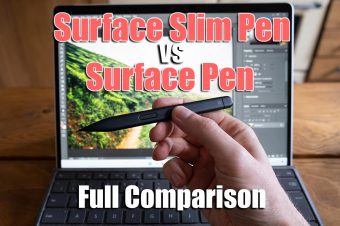


Leave a Reply